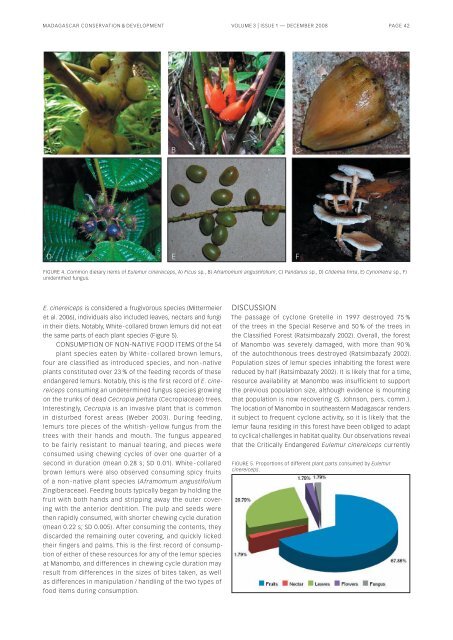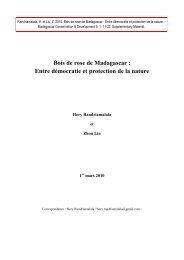Journal Madagascar Conservation - Madagascar Wildlife ...
Journal Madagascar Conservation - Madagascar Wildlife ...
Journal Madagascar Conservation - Madagascar Wildlife ...
You also want an ePaper? Increase the reach of your titles
YUMPU automatically turns print PDFs into web optimized ePapers that Google loves.
MADAGASCAR CONSERVATION & DEVELOPMENT VOLUME 3 | ISSUE 1 — DECEMBER 2008 PAGE 42<br />
A B C<br />
D E F<br />
FIGURE 4. Common dietary items of Eulemur cinereiceps, A) Ficus sp., B) Aframomum angustifolium, C) Pandanus sp., D) Clidemia hirta, E) Cynometra sp., F)<br />
unidentified fungus.<br />
E. cinereiceps is considered a frugivorous species (Mittermeier<br />
et al. 2006), individuals also included leaves, nectars and fungi<br />
in their diets. Notably, White - collared brown lemurs did not eat<br />
the same parts of each plant species (Figure 5).<br />
CONSUMPTION OF NON-NATIVE FOOD ITEMS Of the 54<br />
plant species eaten by White - collared brown lemurs,<br />
four are classified as introduced species, and non - native<br />
plants constituted over 23 % of the feeding records of these<br />
endangered lemurs. Notably, this is the first record of E. cine-<br />
reiceps consuming an undetermined fungus species growing<br />
on the trunks of dead Cecropia peltata (Cecropiaceae) trees.<br />
Interestingly, Cecropia is an invasive plant that is common<br />
in disturbed forest areas (Weber 2003). During feeding,<br />
lemurs tore pieces of the whitish - yellow fungus from the<br />
trees with their hands and mouth. The fungus appeared<br />
to be fairly resistant to manual tearing, and pieces were<br />
consumed using chewing cycles of over one quarter of a<br />
second in duration (mean 0.28 s; SD 0.01). White - collared<br />
brown lemurs were also observed consuming spicy fruits<br />
of a non - native plant species (Aframomum angustifolium<br />
Zingiberaceae). Feeding bouts typically began by holding the<br />
fruit with both hands and stripping away the outer covering<br />
with the anterior dentition. The pulp and seeds were<br />
then rapidly consumed, with shorter chewing cycle duration<br />
(mean 0.22 s; SD 0.005). After consuming the contents, they<br />
discarded the remaining outer covering, and quickly licked<br />
their fingers and palms. This is the first record of consumption<br />
of either of these resources for any of the lemur species<br />
at Manombo, and differences in chewing cycle duration may<br />
result from differences in the sizes of bites taken, as well<br />
as differences in manipulation / handling of the two types of<br />
food items during consumption.<br />
DISCUSSION<br />
The passage of cyclone Gretelle in 1997 destroyed 75 %<br />
of the trees in the Special Reserve and 50 % of the trees in<br />
the Classified Forest (Ratsimbazafy 2002). Overall, the forest<br />
of Manombo was severely damaged, with more than 90 %<br />
of the autochthonous trees destroyed (Ratsimbazafy 2002).<br />
Population sizes of lemur species inhabiting the forest were<br />
reduced by half (Ratsimbazafy 2002). It is likely that for a time,<br />
resource availability at Manombo was insufficient to support<br />
the previous population size, although evidence is mounting<br />
that population is now recovering (S. Johnson, pers. comm.).<br />
The location of Manombo in southeastern <strong>Madagascar</strong> renders<br />
it subject to frequent cyclone activity, so it is likely that the<br />
lemur fauna residing in this forest have been obliged to adapt<br />
to cyclical challenges in habitat quality. Our observations reveal<br />
that the Critically Endangered Eulemur cinereiceps currently<br />
FIGURE 5. Proportions of different plant parts consumed by Eulemur<br />
cinereiceps.



